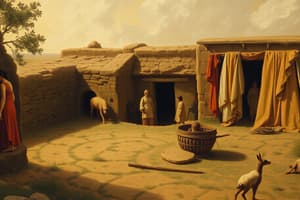Podcast
Questions and Answers
What was a significant feature of Clovis points?
What was a significant feature of Clovis points?
- They were exclusively used for fishing.
- They were made of wood.
- They were only found in caves.
- They had a unique flute/channel along each side. (correct)
Clovis peoples were the first and only inhabitants of North America.
Clovis peoples were the first and only inhabitants of North America.
False (B)
Approximately how many Clovis points have been found throughout North America?
Approximately how many Clovis points have been found throughout North America?
4,400
Clovis populations primarily hunted large animals such as mammoths, bison, and __________.
Clovis populations primarily hunted large animals such as mammoths, bison, and __________.
Match the following aspects of Clovis culture with their descriptions:
Match the following aspects of Clovis culture with their descriptions:
What type of environment did the receding ice sheets create for the Clovis culture?
What type of environment did the receding ice sheets create for the Clovis culture?
What is one possible purpose of the unique design of Clovis points?
What is one possible purpose of the unique design of Clovis points?
The Clovis culture showed little evidence of spiritual beliefs or practices.
The Clovis culture showed little evidence of spiritual beliefs or practices.
What environmental factor contributed to the decline of the Clovis culture?
What environmental factor contributed to the decline of the Clovis culture?
The Clovis culture lasted for more than 1,000 years.
The Clovis culture lasted for more than 1,000 years.
What genetic connection was found from the remains of an infant in Montana?
What genetic connection was found from the remains of an infant in Montana?
The Clovis culture began to decline around ______ years ago.
The Clovis culture began to decline around ______ years ago.
Match the following Clovis culture characteristics with their descriptions:
Match the following Clovis culture characteristics with their descriptions:
Flashcards are hidden until you start studying
Study Notes
Clovis Culture Overview
- First identified through Clovis stone points discovered in the 1920s near Clovis, New Mexico.
- Rapidly spread across North America around 13,500 years ago, marking a period of population growth and cultural expansion.
- Approximately 4,400 Clovis points have been found throughout North America, serving as a hallmark of this culture.
Pre-Clovis and Clovis Distinction
- Debates persisted regarding whether Clovis peoples were the original inhabitants of North America; recent findings of pre-Clovis sites challenge this notion.
- Pre-Clovis sites are geographically scattered and less cohesive compared to the widespread Clovis sites.
Early Inhabitants and Environment
- Evidence indicates human presence in North America between 14,000 and 13,000 years ago.
- The receding Laurentide and Ceran ice sheets transformed the landscape into familiar ecosystems, fostering diverse environments for the Clovis culture.
Clovis Points Technology
- Clovis points innovatively designed with a unique flute/channel along each side; their exact purpose remains ambiguous.
- These stone tools are typically about 4 inches long, with notable large examples measuring over 9 inches found in Washington.
- The fluting technique was sophisticated, requiring skill and precision during production; most points were used as spear tips or darts.
Clovis Lifestyle and Habitats
- Clovis populations were nomadic, exploiting abundant resources across various terrains, including tundra, forests, and coastal areas.
- Campsites were often near rivers and streams, emphasizing availability of food resources and materials for tool-making.
Interaction with Mega Fauna
- Clovis peoples hunted large animals such as mammoths, bison, and horses; hunting strategies likely focused on easier targets.
- Evidence of butchering and kill sites coincides with found Clovis points, particularly in marshy areas supporting large game creatures.
Cultural and Spiritual Aspects
- Evidence suggests Clovis culture had artistic expressions, possibly utilizing red ochre for ritualistic or decorative purposes.
- Burials of stone points and artifacts point to spiritual beliefs, with potential practices around symbolic territory marking.
Population Dynamics and Movements
- Clovis people were highly mobile, traveling vast distances, which minimized population density at any single site.
- Mobile lifestyle likely provided resilience against scarcity, enabling groups to relocate quickly when resources dwindled.
Genetic Ancestry and Connections
- An infant's remains found in Montana were connected genetically to present-day Native American groups and populations in Siberia, suggesting a clear Asian origin of the Clovis peoples.
Extinction Factors
- Clovis culture began to decline around 12,950 years ago, coinciding with the Younger Dryas period associated with climate change.
- A theory proposes a comet impact may have triggered widespread fires and cooling temperatures contributing to extinction events of both mega fauna and Clovis cultures.
Evolution Post-Clovis
- Following the decline of the Clovis culture, regional variations of stone points emerged, indicating shifts in tool-making traditions as resources and population levels changed.
- Movement patterns altered, with shorter distances traveled to local stone sources, leading to diversification of diets and technologies.
Importance of Clovis Culture
- Despite its brief existence of approximately 700 years, the Clovis culture established vital foundations for future Native American cultures across prehistoric North America.
Clovis Culture Overview
- Clovis culture is identified by stone artifacts known as Clovis points, first discovered in New Mexico in the 1920s.
- Originated around 13,500 years ago, this culture expanded rapidly across North America, contributing to population growth.
- Approximately 4,400 Clovis points found throughout North America signify the culture’s extensive reach.
Pre-Clovis and Clovis Distinction
- Ongoing debates regarding Clovis as the first inhabitants of North America; new evidence from pre-Clovis sites challenges traditional views.
- Pre-Clovis sites are generally less organized and more spread out geographically compared to the Clovis sites, indicating differing settlement patterns.
Early Inhabitants and Environment
- Evidence suggests human presence dates back to between 14,000 and 13,000 years ago.
- The landscape transformed as the Laurentide and Ceran ice sheets receded, creating diverse ecosystems conducive to human habitation.
Clovis Points Technology
- Clovis points feature a unique flute or channel design on each side, although their specific uses are still debated.
- Typically about 4 inches long, several large examples exceeding 9 inches have been found in Washington.
- The fluting technique required advanced skill and precision, with most points functioning as spear tips or darts.
Clovis Lifestyle and Habitats
- Nomadic Clovis populations thrived by exploiting a variety of ecosystems, such as tundras, forests, and coastal areas.
- Campsites were strategically located near rivers and streams to provide food and raw materials for tool production.
Interaction with Mega Fauna
- Clovis peoples hunted large animals like mammoths, bison, and horses, utilizing strategies focused on more accessible prey.
- Butchering and kill sites found alongside Clovis points indicate these locations were often in marshy areas frequented by large game.
Cultural and Spiritual Aspects
- Artistic expressions may have been part of Clovis culture, possibly including the use of red ochre in rituals or decoration.
- Burials of artifacts suggest spiritual and symbolic practices, including territory marking among Clovis peoples.
Population Dynamics and Movements
- Clovis groups maintained low population densities due to their highly mobile lifestyle, traveling large distances to access resources.
- This mobility allowed for quick relocation in response to resource scarcity, enhancing group resilience.
Genetic Ancestry and Connections
- Genetic analysis of remains found in Montana links Clovis individuals to modern Native American groups and populations in Siberia, indicating Asian origins.
Extinction Factors
- The decline of the Clovis culture around 12,950 years ago aligns with the Younger Dryas period, characterized by climate change.
- Comet impact theories suggest that associated widespread fires and cooling may have contributed to both mega fauna extinction and the collapse of Clovis culture.
Evolution Post-Clovis
- After the decline of Clovis culture, variations of stone points developed regionally, reflecting changing tool-making traditions and resource availability.
- Shifts in movement patterns occurred, leading to shorter travel distances to local stone sources and greater dietary and technological diversity.
Importance of Clovis Culture
- Spanning approximately 700 years, the Clovis culture laid foundational cultural frameworks for future Native American societies in prehistoric North America.
Studying That Suits You
Use AI to generate personalized quizzes and flashcards to suit your learning preferences.




